For the following exercises, examine the graphs. Identify where the vertical asymptotes are located.
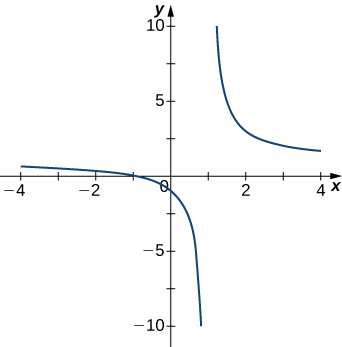
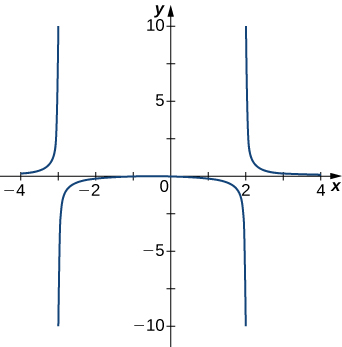
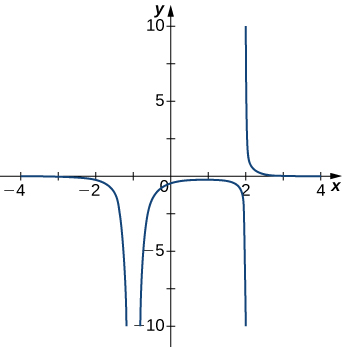
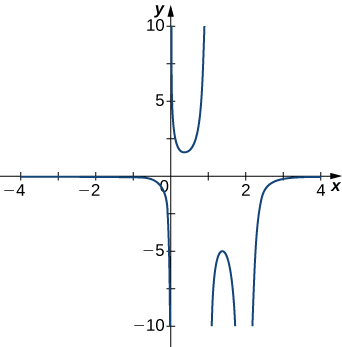
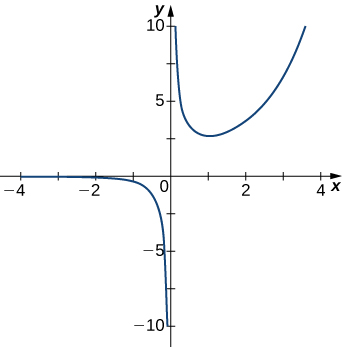
For the following functions [latex]f(x)[/latex], determine whether there is an asymptote at [latex]x=a[/latex]. Justify your answer without graphing on a calculator.
6. [latex]f(x)=\dfrac{x+1}{x^2+5x+4}, \, a=-1[/latex]
7. [latex]f(x)=\dfrac{x}{x-2}, \, a=2[/latex]
8. [latex]f(x)=(x+2)^{3/2}, \, a=-2[/latex]
9. [latex]f(x)=(x-1)^{-1/3}, \, a=1[/latex]
10. [latex]f(x)=1+x^{-2/5}, \, a=1[/latex]
For the following exercises, evaluate the limit.
11. [latex]\underset{x\to \infty }{\lim}\dfrac{1}{3x+6}[/latex]
12. [latex]\underset{x\to \infty }{\lim}\dfrac{2x-5}{4x}[/latex]
13. [latex]\underset{x\to \infty }{\lim}\dfrac{x^2-2x+5}{x+2}[/latex]
14. [latex]\underset{x\to −\infty }{\lim}\dfrac{3x^3-2x}{x^2+2x+8}[/latex]
15. [latex]\underset{x\to −\infty }{\lim}\dfrac{x^4-4x^3+1}{2-2x^2-7x^4}[/latex]
16. [latex]\underset{x\to \infty }{\lim}\dfrac{3x}{\sqrt{x^2+1}}[/latex]
17. [latex]\underset{x\to −\infty }{\lim}\dfrac{\sqrt{4x^2-1}}{x+2}[/latex]
18. [latex]\underset{x\to \infty }{\lim}\dfrac{4x}{\sqrt{x^2-1}}[/latex]
19. [latex]\underset{x\to −\infty }{\lim}\dfrac{4x}{\sqrt{x^2-1}}[/latex]
20. [latex]\underset{x\to \infty }{\lim}\dfrac{2\sqrt{x}}{x-\sqrt{x}+1}[/latex]
For the following exercises, find the horizontal and vertical asymptotes.
21. [latex]f(x)=x-\dfrac{9}{x}[/latex]
22. [latex]f(x)=\dfrac{1}{1-x^2}[/latex]
23. [latex]f(x)=\dfrac{x^3}{4-x^2}[/latex]
24. [latex]f(x)=\dfrac{x^2+3}{x^2+1}[/latex]
25. [latex]f(x)= \sin (x) \sin (2x)[/latex]
26. [latex]f(x)= \cos x+ \cos (3x)+ \cos (5x)[/latex]
27. [latex]f(x)=\dfrac{x \sin (x)}{x^2-1}[/latex]
28. [latex]f(x)=\dfrac{x}{ \sin (x)}[/latex]
29. [latex]f(x)=\dfrac{1}{x^3+x^2}[/latex]
30. [latex]f(x)=\dfrac{1}{x-1}-2x[/latex]
31. [latex]f(x)=\dfrac{x^3+1}{x^3-1}[/latex]
32. [latex]f(x)=\dfrac{ \sin x+ \cos x}{ \sin x- \cos x}[/latex]
33. [latex]f(x)=x- \sin x[/latex]
34. [latex]f(x)=\dfrac{1}{x}-\sqrt{x}[/latex]
For the following exercises, construct a function [latex]f(x)[/latex] that has the given asymptotes.
35. [latex]x=1[/latex] and [latex]y=2[/latex]
36. [latex]x=1[/latex] and [latex]y=0[/latex]
37. [latex]y=4[/latex] and [latex]x=-1[/latex]
38. [latex]x=0[/latex]
For the following exercises (40-44), graph the function on a graphing calculator on the window [latex]x=[-5,5][/latex] and estimate the horizontal asymptote or limit. Then, calculate the actual horizontal asymptote or limit.
39. [T] [latex]f(x)=\dfrac{1}{x+10}[/latex]
40. [T] [latex]f(x)=\dfrac{x+1}{x^2+7x+6}[/latex]
41. [T] [latex]\underset{x\to −\infty }{\lim} x^2+10x+25[/latex]
42. [T] [latex]\underset{x\to −\infty }{\lim}\dfrac{x+2}{x^2+7x+6}[/latex]
43. [T] [latex]\underset{x\to \infty }{\lim}\dfrac{3x+2}{x+5}[/latex]
For the following exercises (45-56), draw a graph of the functions without using a calculator. Be sure to notice all important features of the graph: local maxima and minima, inflection points, and asymptotic behavior.
44. [latex]y=3x^2+2x+4[/latex]
45. [latex]y=x^3-3x^2+4[/latex]
46. [latex]y=\dfrac{2x+1}{x^2+6x+5}[/latex]
47. [latex]y=\dfrac{x^3+4x^2+3x}{3x+9}[/latex]
48. [latex]y=\dfrac{x^2+x-2}{x^2-3x-4}[/latex]
49. [latex]y=\sqrt{x^2-5x+4}[/latex]
50. [latex]y=2x\sqrt{16-x^2}[/latex]
51. [latex]y=\dfrac{ \cos x}{x}[/latex], on [latex]x=[-2\pi ,2\pi][/latex]
52. [latex]y=e^x-x^3[/latex]
53. [latex]y=x \tan x, \, x=[−\pi ,\pi][/latex]
54. [latex]y=x \ln (x), \, x>0[/latex]
55. [latex]y=x^2 \sin (x), \, x=[-2\pi ,2\pi][/latex]
56. For [latex]f(x)=\dfrac{P(x)}{Q(x)}[/latex] to have an asymptote at [latex]y=2[/latex] then the polynomials [latex]P(x)[/latex] and [latex]Q(x)[/latex] must have what relation?
57. For [latex]f(x)=\dfrac{P(x)}{Q(x)}[/latex] to have an asymptote at [latex]x=0[/latex], then the polynomials [latex]P(x)[/latex] and [latex]Q(x)[/latex] must have what relation?
58. If [latex]f^{\prime}(x)[/latex] has asymptotes at [latex]y=3[/latex] and [latex]x=1[/latex], then [latex]f(x)[/latex] has what asymptotes?
59. Both [latex]f(x)=\dfrac{1}{x-1}[/latex] and [latex]g(x)=\dfrac{1}{(x-1)^2}[/latex] have asymptotes at [latex]x=1[/latex] and [latex]y=0[/latex]. What is the most obvious difference between these two functions?
60. True or false: Every ratio of polynomials has vertical asymptotes.
Candela Citations
- Calculus Volume 1. Authored by: Gilbert Strang, Edwin (Jed) Herman. Provided by: OpenStax. Located at: https://openstax.org/details/books/calculus-volume-1. License: CC BY-NC-SA: Attribution-NonCommercial-ShareAlike. License Terms: Access for free at https://openstax.org/books/calculus-volume-1/pages/1-introduction






